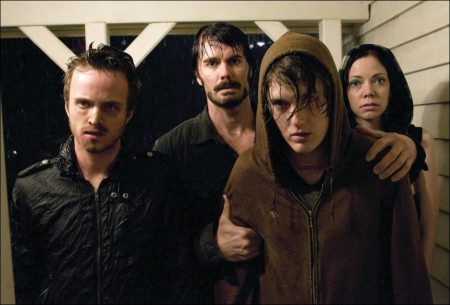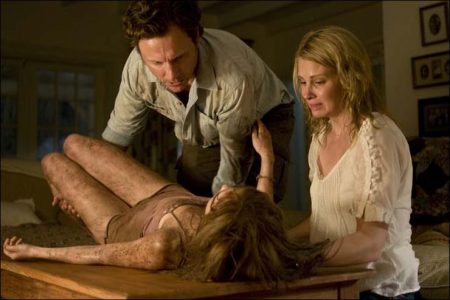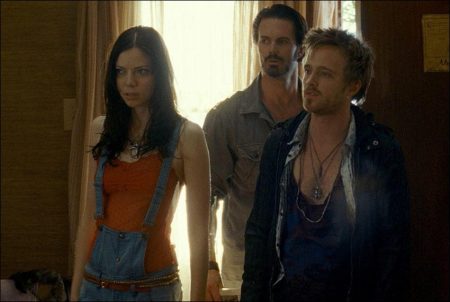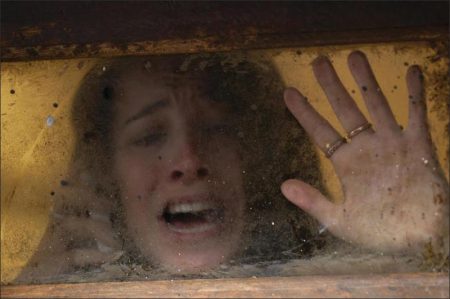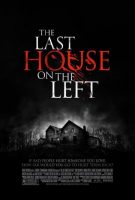Tagline: If bad people hurt someone you love, how far would you go to hurt them back?
The Last House on the Left movie storyline. While being transported by two detectives in a car, the dangerous criminal Krug is rescued by his brother Francis and his girlfriend Sadie, and they brutally kill the detectives. Meanwhile Emma, her husband John, and their daughter Mari Collingwood head to their summer home near the lake. Mari borrows the family car to meet her friend Paige that is working in a store in the town.
While in the store, they befriend a teen boy named Justin, who offers some marijuana to Paige in the motel where he is lodged. While they are smoking marijuana in Justin’s room, Krug, Francis, and Sadie arrive and abduct the girls. Krug drives Mari’s car and she causes them to crash into a tree. Krug stabs Paige and rapes Mari; however Mari manages to escape, swimming in the lake, but Krug shoots her in the back. They walk through the isolated road in the woods and they reach Collingwood’s house telling that they have just had a car accident. Emma and John welcome the strangers until they discover what has happened to their beloved daughter.
The Last House on the Left is a 2009 American horror film directed by Dennis Iliadis and written by Carl Ellsworth and Adam Alleca. It is a remake of the 1972 film of the same name, and stars Tony Goldwyn, Monica Potter, Garret Dillahunt, Spencer Treat Clark, Martha MacIsaac and Sara Paxton. The film follows the parents (Goldwyn and Potter) of Mari Collingwood (Paxton), who attempt to get revenge on a group of strangers, led by a man named Krug (Dillahunt), that have taken shelter at their home during a thunderstorm.
On its opening day, The Last House on the Left grossed $5,630,345, on 2,800 screens across 2,402 theaters, putting it slightly ahead of Watchmen, the previous weekend’s top film, with approximately $5,304,344. From March 13 – 15, The Last House on the Left took in an additional $5,318,215 and $3,170,125, respectively, to round out its opening weekend with $14,118,685. By comparison, the 1972 original earned an estimated $3.1 million, in unadjusted dollars, during its entire box office run. Adjusting for inflation, that would be approximately $16,468,225 in 2009. As of August 18, 2009 the film has grossed $45,286,226 worldwide.
A Cult Classic: Craven and Cunningham Redesign Fear
With a career spanning more than three decades, Wes Craven has become a cultural phenomenon in film and television. He reinvented the horror genre in 1984 with the classic A Nightmare on Elm Street, which he wrote and directed, and in the next decade he deconstructed the genre again with the successful Scream trilogy. These two franchises have earned nearly one billion dollars and serve as a demonstration of his profound understanding of the often unconscious fears roiling in the human psyche.
But Craven’s success in probing the roots of terror began in 1972 with his first film, the landmark shocker The Last House on the Left. The film was produced by fellow horror master Sean Cunningham, who went on Dr. John (Tony Goldwyn) and Emma Collingwood (Monica Potter) hunt killers. to launch a juggernaut franchise of his own with his monumentally successful Friday the 13th.
In the early ’70s, Vietnam raged as American college students protested the war. Millions were disillusioned by the battle carnage filling their television screens each evening. Too, citizens saw injustices within their own borders. Young people were challenging status quo approaches to hot-button issues such as civil, women’s and gay rights. Mirroring this revolutionary attitude, a new generation of filmmakers expanded the boundaries of conventional cinema.
Among them were Craven and Cunningham, who quietly commenced work on a film that would change the course of modern thrillers. “Last House was very much a product of its era,” offers Craven. “It was a time when all the rules were out the window, when everybody was trying to break the hold of censorship. We were all very antiestablishment at that time. The Vietnam War was going on, and the most powerful footage we saw was in actual documentary films of the war. In Last House, we set out to show violence the way we thought it really was and to show the dark underbelly of the Hollywood genre film. We consciously took all the B-movie conventions and stood them on their heads.”
A university literature professor before he switched careers, Craven took inspiration for the project from the Ingmar Bergman film Jungfrukällan (The Virgin Spring), which is actually based upon the medieval Swedish ballad “Töres dotter i Wänge” (“Töre’s Daughter in Vänge”). At the time, Last House was a drastic departure from the vapid mad-scientist monster movies prevalent in the late 1960s and early ’70s.
The two filmmakers weren’t sure if their low-budget film filled with controversial subject matter would attract an audience. Indeed, they were simply interested in the exercise of making a feature film. “When Sean and I made The Last House on the Left, our attitude was that we were going to do this tiny little film and it was only going to be shown in two or three theaters,” remembers Craven. “Nobody was ever going to see it, and nobody was ever going to know we did it. So, we essentially said, `We’re going to show things that people have never seen before on a movie screen. We’ll pull out all the stops and just do whatever the hell we want.’”
The original version of Last House was, as Cunningham describes, “a guerilla film.” It was made with a skeleton crew of 15 members and a budget of just under $100,000. In order to save money, the movie was mostly filmed in houses belonging to the crew’s families in Westport, Connecticut. “It was just one of those things,” remembers Cunningham, “where somebody says, `Hey, I’ve got an idea…let’s make a movie! You write; I’ll produce; you direct. I’ll make sandwiches, and I’ll take sound.’It was very primitive, student-level filmmaking. It was like doing a high school play where everyone works around the clock for no other reason than to do the play. We were literally kids running around with a camera.”
With such humble origins, little did anyone suspect the film would become a box-office sensation and revolutionize modern thrillers. Of the opening weekend, Craven recalls, “I called to check with Sean and see what was happening with the movie. He said, `Are you sitting down?’A moment later he said, `It’s a hit; it’s a smash; they are lined up around the block to see it.’” After a successful first run, the controversial film went on to play for years at college campuses and midnight screenings, where it became rite-of-passage viewing for young horror buffs.
In compliment to its commercial success, Chicago Sun Times film critic Roger Ebert championed the film. The young reviewer called Last House “a tough, bitter little sleeper of a movie that’s about four times as good as you’d expect… one of those rare, unheralded movies that succeeds and still achieves a great deal more.”
Within the film industry, modern-day “splat pack” directors such as Alexandre Aja and Eli Roth credit Last House with being extremely influential on their own aesthetics. To reimagine Craven and Cunningham’s masterpiece, they would welcome to their exclusive club a new member…a young Greek director named Dennis Iliadis.
Continue Reading and View the Theatrical Trailer
The Last House on the Left (2009)
Directed by: Dennis Iliadis
Starring: Tony Goldwyn, Monica Potter, Sara Paxton, Garret Dillahunt, Rhys Coiro, Martha MacIsaac, Riki Lindhome, Aaron Paul, Michael Bowen, Spencer Treat Clark, Tony Goldwyn
Screenplay by: Carl Ellsworth
Production Design by: Johnny Breedt
Cinematography by: Sharone Meir
Film Editing by: Peter McNulty
Costume Design by: Katherine Jane Bryant
Art Direction by: Shira Hockman, Cecelia van Straaten
Special Effects: Süpervizörü Jamison Goei
Music by: John Murphy
MPAA Rating: R for sadistic brutal violence including a rape and disturbing images, language, nudity and some drug use.
Oizüdisuüeo sl: Rogue Pictures
Release Date: March 13, 2009
Views: 73
